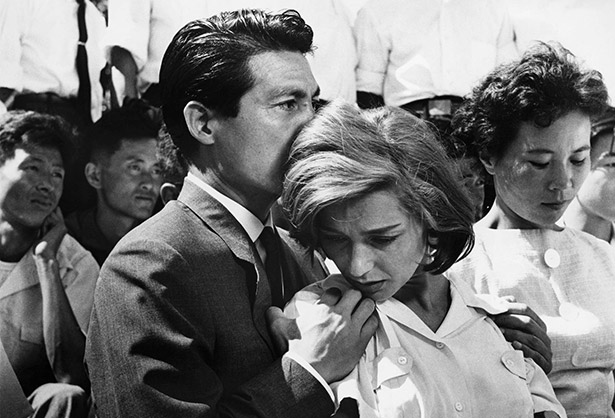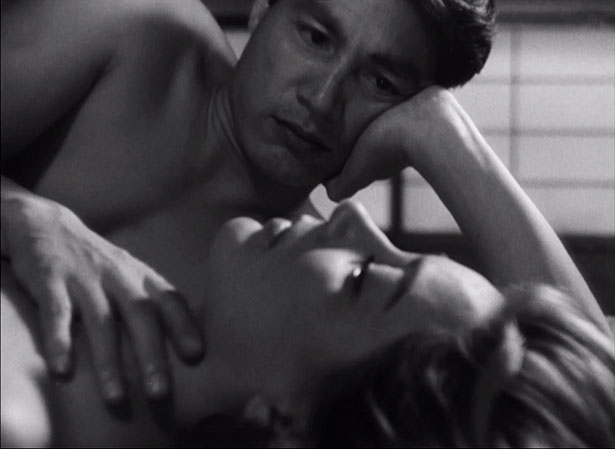
Your feedback and comments are appreciated. See Contact page for e-mails.

Hiroshima mon amour
REVIEW by Richard Rivera
Hiroshima mon amour, directed by Alain Resnais was released in 1959, only fourteen years after the apocalyptic devastation of the first atomic bomb ever used in war at the end of World War II. The movie was filmed on location in Japan and stars a Japanese leading man, Eiji Okada, and the French actress Emmanuelle Riva. It was a joint bi-cultural production.
Hiroshima mon amour, which is part love story and documentary, rich in metaphor, tells a tale of two strangers immobilized like creatures in amber, unable to move forward or escape their past, while seeking refuge from their lives.
As metaphor the film is the meeting of East and West having a dialogue on the madness of war but it is also much more. It forces the West to acknowledge the horrors of a new found weapon that in less than a decade had become an accepted component in the arsenal of war.
In the film, Riva’s character is an actress in a movie being filmed in Japan. She meets Okada, an architect, by chance. They are complete strangers and yet connect in such a primal way that they spend the night together.
Abstract in its black-and-white cinematography, atypical in its eroticism, flashbacks, and juxtaposition of images, Hiroshima mon amour is unconventional modern cinema. The dialogue is dreamlike, haltingly poetic, and akin to recitation in its phrasing and philosophic non sequiturs. All of this is in stark contrast to the opening of the film with its harsh depiction of the horrors of war, the dropping of the bomb, and the trauma of the residents.
Most of the film is leisurely paced and tranquil on the surface, with a tension or undercurrent of anger and barely restrained violence that is evident in the nude sequences and later scenes. From the very start the director also shows us two characters communicating on a deep emotion level, sensually, without words or plot to give context to their actions. The film explores the void of post-traumatic existence, the pain of rejection and alienation, and the sensuality that some are drawn to as a means of healing.
Hiroshima mon amour is masterfully shot in black-and-white and plays with visual metaphors, such as having characters in conversation while one is subdued in shadow and the other one brightly illuminated. It delves into the character’s emotional distancing as a means of survival, the joy of bonding with another soul, and the complex duality of personalities that prize their individual freedom while they simultaneously crave the closeness of sexual intimacy.
Cinephiles consider Mr. Resnais to be one of the most influential and major filmmakers of the 20th century and this new Blu-ray release (July 2015) of the film as part of the Criterion Collection displays the lovely mid-tone gray values and wide dynamic range of the original. It is a wonderful 4K version that also retains the aspect ratio 1.37:1 of the original film. Lovers of cinema and Resnais work will not be disappointed.
Hiroshima mon amour, with its austere cinematic beauty and accompanying harshness reminds us of a time when films prompted us to reflect and thoughtfully reconsider the past… a rare occurrence in films nowadays.
October 7, 2015

Eiji Okada and Emmanuelle Riva in Hiroshima mon amour.
Camera Sense Archives
APRIL 2015
Book review
iPad software
Movie review
Underwater dual-use camera review
Photo commentary
Book review
PhotoTech commentary
The Interview, movie review
Photo enhancement or management
MAY 2015
Photo Tech commentary
Photo/Art commentary
Camera review
TV series review
JUNE 2015
JULY 2015
AUGUST 2015
SEPTEMBER 2015
OCTOBER 2015
NOVEMBER 2015
DECEMBER 2015
Copyright © 2015 Richard Rivera & Rivera Arts Enterprises All rights reserved. No copying or reproduction of any kind without express written permission from Richard Rivera
Legal Disclosure Camera Sense and Eagles of New York are trademarks of Elk Partners LLC